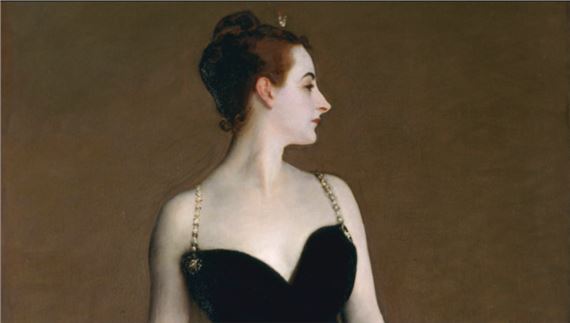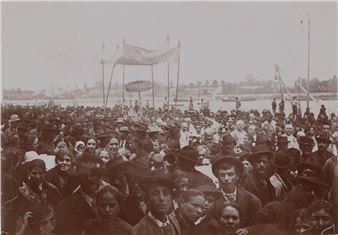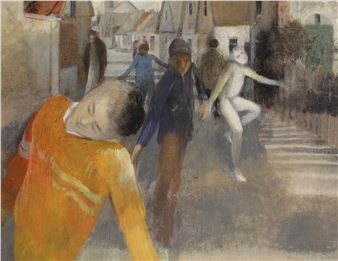Sargent: Dazzling Paris
John Singer Sargent (Florence, 1856 – London, 1925), along with James McNeill Whistler, was the most famous American artist of his generation and certainly one of the greatest painters of the 19th and early 20th century. Revered in the United States (his Portrait of Madame X is regarded as the Mona Lisa of the American art collection conserved by the Metropolitan Museum of Art in New York), he is also famous in the United Kingdom, where he spent most of his career. In France, however, his name and work remain largely unknown, a situation that the exhibition at the Musأ©e d'Orsay in fall 2025 hopes to change.
No monographic exhibition has previously been devoted to John Singer Sargent in France. Yet it was in France that the young painter received his training, developing his style and network of artists. It was there that he also enjoyed his first successes and created a number of his masterpieces, including Dr Pozzi at HomeHome (1881, Hammer Museum, Los Angeles) and The Daughters of Edward Darley Boit (1882, Museum of Fine Arts, Boston). Designed in partnership with the Metropolitan Museum of Art in New York, the exhibition "Sargent. The Paris Years" aims to introduce the painter to a wide audience. The exhibition brings together over 90 of John Singer Sargent’s works, including some that have never been exhibited in France. It traces the meteoric rise of the young artist, who arrived in Paris in 1874, when he was eighteen years old, to study with Carolus-Duran. The exhibition covers his career up to the mid-1880s, when he moved to London after the scandal caused by his portrait of Madame Gautreau (Madame X) at the Salon.
During that decade, Sargent forged his style and personality alike in the crucible of Paris’ head-spinning art scene, marked by the proliferation of exhibitions, development of naturalism and impressionism, and Paris’ ascendancy as art capital of the world. The young American painter found no lack of support there from other expatriates and also made himself at home in French society, forging ties with a circle of artists, writers and enlightened patrons. The many effigies that Sargent has left us of these personages paint a fascinating portrait of a highly cosmopolitan, rapidly changing society in which the old European aristocracy rubbed shoulders with the new world’s moneyed youth. Always in search of fresh inspiration, Sargent spent little time depicting “Parisian lifeâ€, but took advantage of his base in the French capital to make frequent journeys around Europe and in North Africa. He brought back numerous paintings from them, landscapes and genre scenes that combine exoticism, mystery and sensuality. But it was in the field of portraiture that Sargent established himself as the most talented artist of his day, surpassing his masters and equaling the great artists of the past. His extraordinary technical skill, the vivacity of his touch, iridescence of his colours and provocative assurance of his compositions unsettled the public and impressed the critics, who saw him as the worthy successor to Velأ،zquez. In 1883, commenting on one of his most original paintings, the Portrait of the Daughters of Edward Darley Boit, the American writer Henry James, friend of Sargent, noted that the artist “offers the slightly â€کuncanny’ spectacle of a talent which on the very threshold of its career has nothing more to learn.â€
In 1884, the portrait of Virginie Gautreau, which Sargent would later describe as “the best thing he had ever doneâ€, nonetheless aroused hostile reactions at the Salon. They were aimed in particular at its model’s morality and testified to the worldly and social issues at play in the art of the “public†portrait in France in the late 19th century. A special section of the exhibition is devoted to that episode in Sargent’s career and to the painting in question, on exceptional loan from the Metropolitan Museum of Art and on view in Paris for the first time since 1884. Based on extensive research, “Sargent. The Paris Years†also takes stock of the lasting ties the artist retained with the city he was trained in, even after his move to London. His engagement in favour of Manet’s Olympia, the work of an artist he admired, being added to the national collections in 1890 bears witness to it. It was also in France that Sargent enjoyed a first form of institutional recognition, as the State purchased his Portrait of the Dancer Carmencita for the Luxembourg Museum in 1892

Recommended for you
John Singer Sargent (Florence, 1856 – London, 1925), along with James McNeill Whistler, was the most famous American artist of his generation and certainly one of the greatest painters of the 19th and early 20th century. Revered in the United States (his Portrait of Madame X is regarded as the Mona Lisa of the American art collection conserved by the Metropolitan Museum of Art in New York), he is also famous in the United Kingdom, where he spent most of his career. In France, however, his name and work remain largely unknown, a situation that the exhibition at the Musأ©e d'Orsay in fall 2025 hopes to change.
No monographic exhibition has previously been devoted to John Singer Sargent in France. Yet it was in France that the young painter received his training, developing his style and network of artists. It was there that he also enjoyed his first successes and created a number of his masterpieces, including Dr Pozzi at HomeHome (1881, Hammer Museum, Los Angeles) and The Daughters of Edward Darley Boit (1882, Museum of Fine Arts, Boston). Designed in partnership with the Metropolitan Museum of Art in New York, the exhibition "Sargent. The Paris Years" aims to introduce the painter to a wide audience. The exhibition brings together over 90 of John Singer Sargent’s works, including some that have never been exhibited in France. It traces the meteoric rise of the young artist, who arrived in Paris in 1874, when he was eighteen years old, to study with Carolus-Duran. The exhibition covers his career up to the mid-1880s, when he moved to London after the scandal caused by his portrait of Madame Gautreau (Madame X) at the Salon.
During that decade, Sargent forged his style and personality alike in the crucible of Paris’ head-spinning art scene, marked by the proliferation of exhibitions, development of naturalism and impressionism, and Paris’ ascendancy as art capital of the world. The young American painter found no lack of support there from other expatriates and also made himself at home in French society, forging ties with a circle of artists, writers and enlightened patrons. The many effigies that Sargent has left us of these personages paint a fascinating portrait of a highly cosmopolitan, rapidly changing society in which the old European aristocracy rubbed shoulders with the new world’s moneyed youth. Always in search of fresh inspiration, Sargent spent little time depicting “Parisian lifeâ€, but took advantage of his base in the French capital to make frequent journeys around Europe and in North Africa. He brought back numerous paintings from them, landscapes and genre scenes that combine exoticism, mystery and sensuality. But it was in the field of portraiture that Sargent established himself as the most talented artist of his day, surpassing his masters and equaling the great artists of the past. His extraordinary technical skill, the vivacity of his touch, iridescence of his colours and provocative assurance of his compositions unsettled the public and impressed the critics, who saw him as the worthy successor to Velأ،zquez. In 1883, commenting on one of his most original paintings, the Portrait of the Daughters of Edward Darley Boit, the American writer Henry James, friend of Sargent, noted that the artist “offers the slightly â€کuncanny’ spectacle of a talent which on the very threshold of its career has nothing more to learn.â€
In 1884, the portrait of Virginie Gautreau, which Sargent would later describe as “the best thing he had ever doneâ€, nonetheless aroused hostile reactions at the Salon. They were aimed in particular at its model’s morality and testified to the worldly and social issues at play in the art of the “public†portrait in France in the late 19th century. A special section of the exhibition is devoted to that episode in Sargent’s career and to the painting in question, on exceptional loan from the Metropolitan Museum of Art and on view in Paris for the first time since 1884. Based on extensive research, “Sargent. The Paris Years†also takes stock of the lasting ties the artist retained with the city he was trained in, even after his move to London. His engagement in favour of Manet’s Olympia, the work of an artist he admired, being added to the national collections in 1890 bears witness to it. It was also in France that Sargent enjoyed a first form of institutional recognition, as the State purchased his Portrait of the Dancer Carmencita for the Luxembourg Museum in 1892
Artists on show
Contact details

Related articles
Here is Le Monde's selection of must-see art exhibitions, from painter John Singer Sargent to medieval forgeries to contemporary Nigerian artist Otobong Nkanga, which will go on display through the end of the year.
While revered by major museums in the United States, the painter remains little known in France. This first exhibition, which focuses on his Parisian years, seeks to correct that oversight.
The newly discovered masterpiece has drawn comparisons to Madame X, and is having its public debut in a new blockbuster Sargent exhibition at the Musأ©e d'Orsay.
Assembling more than 90 works, many of which are returning to France for the first time since their creation, the exhibition John Singer Sargent.

 ARTISTS
ARTISTS















